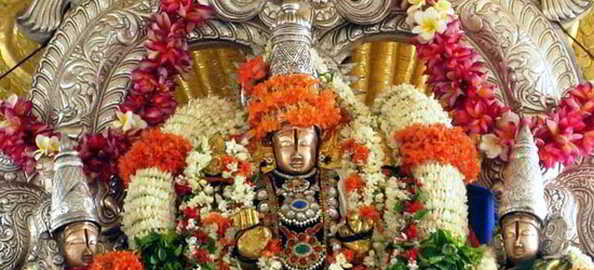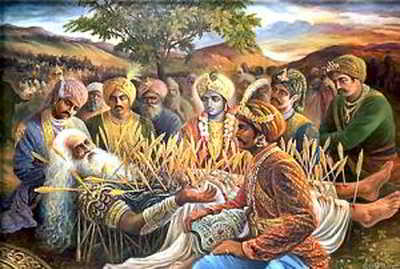Article by : Sadagopan Iyengar Swami, Coimbatore
Srimate SrivanSatakopa Sri Vedanta Desika Yatindra Mahadesikaya nama:
Acquisition of knowledge is always through the asking of questions. Most of the significant inventions and discoveries that have revolutionised our lives were the result of questions that arose in the minds of scientists or would-be scientists. We are told that the child’s brain expands exponentially from birth to the fifth year–this again is reflected in the innumerable queries that children pose to their parents and to whomsoever would listen.
In the spiritual sphere too, it is questions which have revealed to seers the esoteric truths about themselves and their Maker. In fact, an entire Upanishad, the Kenopanishad, is in the form of questions and answers thereto, which teach us all that we need to know about the Lord and His attributes. The Upanishad begins with the omnibus question as to who is the moving spirit behind the activities of the mind, life spirit, speech, eyes and ears-
“Kena ishitam patati preshitam mana: kena praana: prathama: preti yukta:
Kena ishitaam vaacham imaam vadanti chakshu: shrotram ka u Devo yunakti”.
The rest of the Upanishad consists of the Acharya’s enlightening responses to these questions.
Another gem of the same genre is the Prasnopanishad, which too describes illustrious disciples in search of the Paramatma, seeking enlightenment through questions addressed to Pippalaada Maharshi. It is instructive to note that even though the Maharshi is aware of the credentials of the seekers, still, he advises them to perform penance for a year, and then come to him with their queries. This is required, so that the receivers of knowledge appreciate its value.
At the end of the prescribed period, Kabandhee, son of Kaatyaayana, queries Pippalaada as to where all the creation stems from-“Bhagavan! Kuto ha vaa imam: prajaa: prajaayante?”
Another guide book of instructions which was born out of questions is the acclaimed Epic Srimad Ramayanam. It is in response to the pointed queries of Sri Valmiki, seeking to know who was the sole repository of various virtues, (“Konvasmin saampratam loke gunavaan kascha veeryavaan”),that Sri Narada comes out with the exalted Rama charitam.
Not only this, an entire chapter (100th Sargam of Ayodhya Kaandam), of about 75 slokas, is comprised of questions, put by Sri Rama to Bharata. These queries relate to good governance, welfare of those near and dear, etc. Known as the “Kacchit” Sargam, this chapter gives us a lot of information on how advanced the system of administration and justice was, in the Kosala Rajyam.
We see thus that the Question has had an extremely important place in the spread of knowledge, secular and spiritual.
However, are questions necessary? Shouldn’t a wise man reveal to others all that he knows unprompted, so that the spread of wisdom is quick and easy, without waiting for someone to raise questions?
“Do not volunteer information, especially spiritual, without being asked earnestly therefor”, say the Shastras, which are categorical that none should be taught esoteric truths without an ardent yearning therefor, so that the pearls of wisdom are not cast before swine of the spiritual sphere. No Acharya should impart religious instruction without earnest and ardent questioning by a sincere seeker. In a lighter vain, Upanyaasakas point out the case of Arjuna, to whom Sri Krishna revealed all , without the former ardently seeking the same-at the end, Arjuna tells Gitacharya that the elaborate discourse he had heard till then was confusing, beseeching the latter to let him know in a nutshell what was good for him.
And when you do have a substantial question as did the sages of Prasnopanishad, how should you approach your Guru for enlightenment? The student should go to the Acharya with all humility and an earnest desire to know. He should take the Acharya an offering, however humble (“Samith paanim shrotriyam Brahma nishttam”). And there is a time and place for questions-you should not interrupt the teacher when he is in full flow, but should bide your time till he asks, “Any questions?” This we learn from Swami Desikan’s Nyaasa Vimsati, where he emphasises that the sishya must ask questions, but at the appropriate time-“Prasna kaala prateeksha:”
It is this spirit of inquiry, leading to remarkable revelations, that characterises our scripture. Nowhere are we given concepts and asked to believe in them axiomatically-questions are raised and logical answers furnished, which strengthen our faith in the system and its tenets.
If you think that only Ramayana has a question and answer theme, you would be mistaken. Even Sri Mahabharatam has several episodes of queries being put and answers elicited, during which process several subtle points of Dharma emerge. There are at least three of these sessions in which Yudhishttira figures. Twice questions are asked of him and once he asks the questions.
Sri Mahabharatam narrates two occasions, where questions and answers thereto played a crucial role in saving lives. Whether the person concerned would live or die depended on the answers to the queries.
A huge python encircles Bhima, rendering even the mighty warrior incapable of extricating himself. Dharmaputra arrives on the scene, to be told by the serpent that unless he answered its questions truthfully and correctly, Bhima would certainly be swallowed. With his fund of wisdom acquired from venerated sages, Yudhishttira is able to reply to the python’s queries satisfactorily and thereby save Bhima.
On the second occasion, when all his brothers had been rendered unconscious for defying a “Yaksha”, from whose pond they were trying to drink water, it is Dharmaputra again who comes to their rescue, by furnishing enlightening and informative replies to a series of questions posed by the Yaksha, which are collectively known as the Yaksha Prasnam.
However, the best set of questions for which Yudhishttira is remembered, is of course that in the Aanusaasinaka Parva of Sri Mahabharata. A perusal of the Epic would reveal an endearing trait on the part of Dharmaputra-whenever the occasion arises, whenever a sage or Maharshi is chanced upon, the scion of the Pandava clan exhibits an insatiable thirst for wisdom and plies the venerated visitor with pointed questions. Thus the eldest Pandava is a role model for all seekers, intent on acquiring wisdom and availing all opportunities therefor.
Coming back to Yudhishttira’s questions, these are addressed to the venerated Bheeshma, who lies on a bed of arrows, awaiting the arrival of Uttaraayanam for shedding his mortal coils. Six pointed questions are asked by Dharmaputra, who is always focussed on ways and means for emancipation. If we look at these questions closely, we find that they cover the entire gamut of all that is to be learnt by a spiritual seeker, expecting as an answer no less than the Five Fundamentals of spiritual wisdom, collectively known as “Arttha Panchakam”. It is in reply to these six glorious questions that the entire Vishnu Sahasranama Stotram unfolds, recounted with relish by the scholarly son of Saantanu.
“Who is the only Deity in this world? Which is the sole and supreme goal? Whom should men adulate and adore to attain all that is good? Which Dharma is held by you to be supreme amongst all? By reciting what does a person rid himself of the shackles of Samsara?”
(“Kim ekam daivatam loke, kim vaapi ekam paraayanam
Stuvanta: kam, kam archanta: praapnuyu: maanava: subham
Ko dharma: sarva dharmaanaam bhavata: paramo mata:
Kim japan muchyate jantu: janma samsaara bandhanaat”)
These questions afford an opportunity for Sri Bhishma for singing the praises of the Ultimate and result in the unravelling of the renowned Sri Vishnu Sahasranama Stotram, which is held to be the highpoint of the entire Mahabharatam, apart from the Bhagavat Gita. Besides being a comprehensive compendium of the Lord’s haloed names, the Sahasranama Stotram has the distinction of enunciating rare philosophical truths, which a perusal of Sri Parasara Bhattar’s commentary would reveal. One must indeed appreciate Dharmaputra for having known exactly what questions to ask, so as to elicit for posterity a rare treasure like Sri Vishnu Sahasranamam. We often hear the phrase “Million Dollar Question”-if ever there was a case of each question being worth its weight in gold or diamonds, the six glorious questions of Yudhishttira easily qualify for the top slot without competition.
Many public speakers or even teachers often dread the question-and-answer sessions that usually form the concluding part of the programme.
It is easy to engage in a monologue, but unless you have a command of the subject, it is infinitely more difficult to face pointed questions.
As a so-called specialist in Foreign Exchange, I used to be a Guest Faculty at our Bank’s staff training college. At the end of a session during which I found the participants unusually docile and attentive, when I asked, “Any questions?”, a forest of hands went up. I was heartened at the response and mentally congratulated myself on having mesmerised the audience with my oratorical skills. All prepared to enlighten the trainees about the intricacies of Foreign Exchange, I asked the gentleman in the front row to state his doubt. His query was simple, straight-forward, apparently representative of the entire class and also spoke volumes about the “attentive” audience-“Sir, when will this session end?”
Srimate Sri LakshmiNrisimha divya paduka sevaka SrivanSatakopa Sri Narayana Yatindra Mahadesikaya nama:
dasan, sadagopan
Article by : Sadagopan Iyengar Swami, Coimbatore










